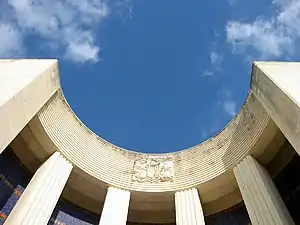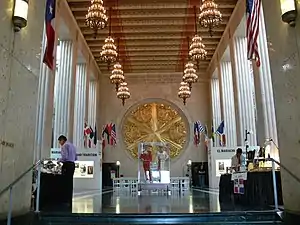Hall of State
The Hall of State (originally the State of Texas Building) is a building in Dallas's Fair Park that commemorates the history of the U.S. state of Texas and is considered one of the best examples of Art Deco architecture in the state. It was designed and built for the Texas Centennial Exposition.
Hall of State | |
 Exterior of the Hall of State | |
 Hall of State  Hall of State | |
| Location | 3939 Grand Ave., Dallas, Texas |
|---|---|
| Coordinates | 32°46′51″N 96°45′40″W |
| Built | 1936 |
| Architect | Donald Barthelme, Adams & Adams, et al |
| Architectural style | Art Deco |
| Part of | Texas Centennial Exposition Buildings (1936-1937) (ID86003488[1]) |
| TSAL No. | 8200000213 |
| RTHL No. | 6732 |
| DLMKHD No. | H/33 (Fair Park) |
| Significant dates | |
| Designated CP | September 24, 1986 |
| Designated TSAL | January 1, 1984 |
| Designated RTHL | 1981 |
| Designated DLMKHD | March 4, 1987[2] |
History
Built in 1936 at the astronomical (especially during the Great Depression) price of $1.2 million, the building was the most expensive per unit area of any structure built in Texas. It was designed for the centennial of the Republic of Texas by architect Donald Barthelme[3] in the beaux arts style and is considered one of the most representative examples of art deco architecture in Texas. According to documents from the Dallas Historical Society Centennial archives collection, John F. Livers designed and manufactured the majority of the Art Deco ornamental metalwork at his Livers Lighting and Bronze Company in Kansas City, Missouri, including the light fixtures. The Hall of State is the culmination of the 1,500-foot (460 m) long Esplanade of State which is flanked by six exhibition pavilions and features a long reflecting pool. It was built using Texas limestone and features memorials to many of the heroes of Texas history.
Current
The Dallas Historical Society has been responsible for managing the Hall of State since 1938. The Hall of State is listed on the National Register of Historic Places as a part of Fair Park. In 1986, the building was restored at a cost of approximately $1.5 million, and the G.B. Dealey Library was opened.
The G.B. Dealey Library, located in the East Texas room of the Hall of State, holds more than ten thousand bound volumes and three million historic documents, including Sam Houston's handwritten account of the battle of San Jacinto.
The Dallas Historical Society rents the Hall of State for events and provides guided tours to school groups.
The structure became a Recorded Texas Historic Landmark in 1981.[4]
The American Museum of the Miniature Arts is currently located at the Hall of State.
Architecture



The curved exedra at the entrance to the Hall of Texas features 76-foot (23 m) tall limestone pillars sit in front of blue tiles designed to evoke the state's flower, the bluebonnet (Lupinus texensis). In the center, above the entrance is an 11-foot (3.4 m) bronze with gold leaf statue by Allie Tennant[5] of the "Tejas Warrior": an archer holds high a bow without an arrow, meant to symbolize peace.
Inside the Hall of State is the Hall of Heroes, which features six bronze statues of James Fannin, Mirabeau B. Lamar, Stephen F. Austin, Sam Houston, Thomas Jefferson Rusk and William B. Travis. There are also bronze plaques that commemorate the Battle of the Alamo and the Battle of San Jacinto. Outside, a statue of Robert L. Thornton, benefactor of the State Fair of Texas and former Mayor of Dallas stands, overlooking the esplanade.
On the exterior frieze, the Hall of State commemorates 60 prominent historical figures in Texas' history:
- Edward Burleson
- Branch Tanner Archer
- Thomas Jefferson Rusk
- William B. Travis
- James Stephen Hogg
- Richard Ellis
- Mirabeau B. Lamar
- Ben Milam
- David G. Burnet
- John Coffee "Jack" Hays
- James Smith (Texas General)
- Albert Sidney Johnston
- Stephen F. Austin
- James Bonham
- Davy Crockett
- Sam Houston
- J. Pinckney Henderson
- Oran M. Roberts
- Lorenzo de Zavala
- James Bowie
- John Reagan
- Anson Jones
- James Fannin
- Gail Borden
- William H. Wharton
- Peter Bell
- José Antonio Navarro
- Elisha M. Pease
- Samuel May Williams
- Ben McCulloch
- James W. Robinson
- Matthew Caldwell
- James Collinsworth
- John Hemphill
- George Childress
- Thomas Green
- R.T. Wheeler
- William B. Franklin
- Henry Wax Karnes
- Moseley Baker
- Walter P. Lane
- Patrick Churchill Jack
- Francisco Vásquez de Coronado
- Alonso Alvarez de Pineda
- Alonso de León
- Alvar Nuñez Cabeza de Vaca
- Hamilton Prieleaux Bee
- William Read Scurry
- Memucan Hunt Jr
- Frank Johnson
- Samuel Price Carson
- Sidney Sherman
- Abner Smith Lipscomb
- George Washington Hockley
- Henry Weidner Baylor
- Robert McAlpin Williamson
- Menefee (either William Menefee or John Menefee)
- Thomas Jefferson Chambers
- Isaac Van Zandt
- Thomas S. Lubbock
See also
References
- "National Register Information System". National Register of Historic Places. National Park Service. November 2, 2013.
- "Ordinance No. 27079" (PDF). City of Dallas. 2008. Retrieved August 16, 2018.
- Hall of State FAQs Archived 2008-05-12 at the Wayback Machine, Dallas Historical Society
- "Texas Historic Sites Atlas". Texas Historical Commission. Archived from the original on July 13, 2012. Retrieved March 17, 2013.
- Hendricks, Patricia D. and Becky Duval Reese, A Century of Sculpture in Texas: 1889-1989, University of Texas, Austin, 1989 p. 45

